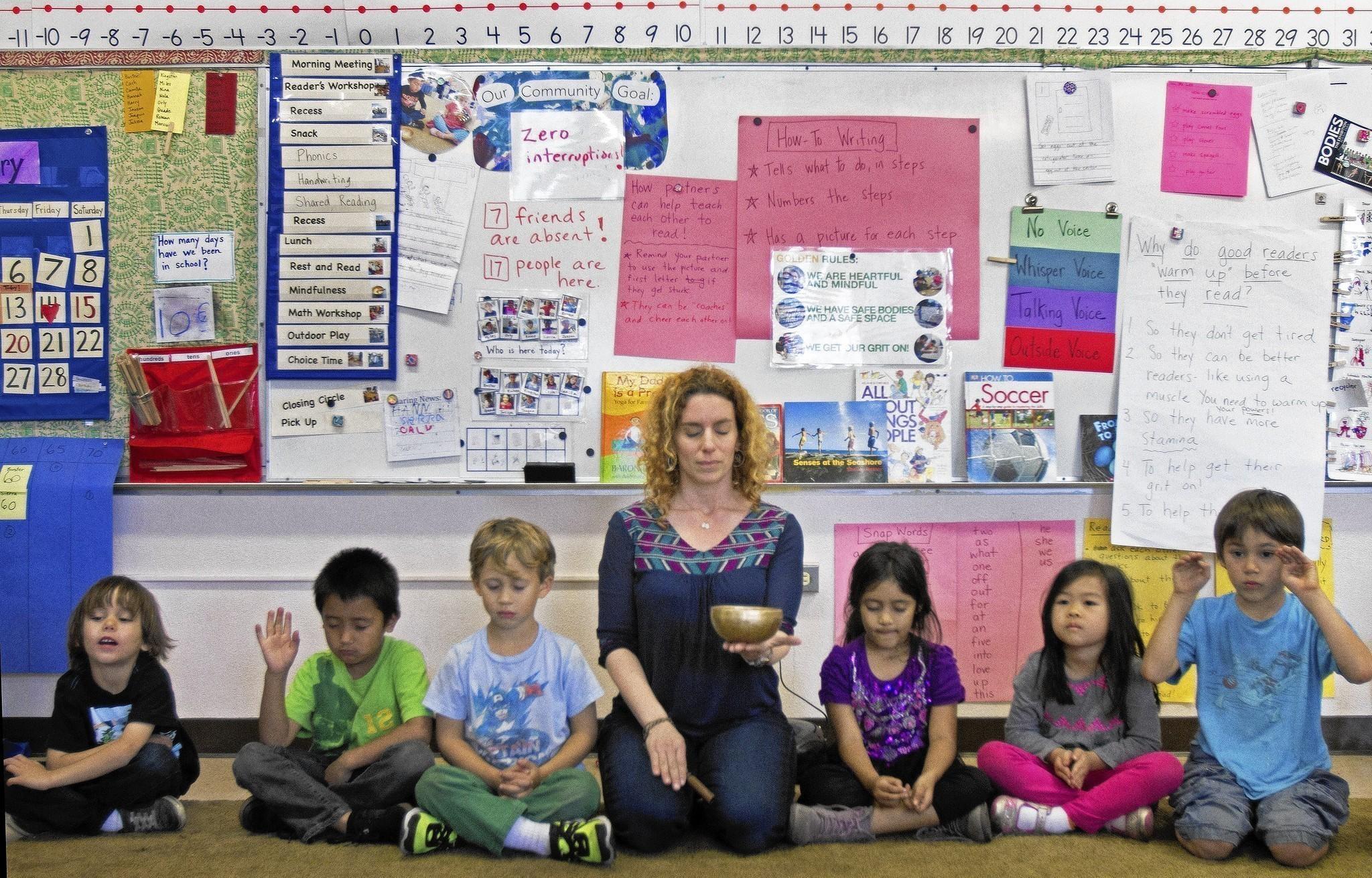Trending: Mindfulness in Schools
June 19, 2014 :: Admissionado Team

What is mindfulness? (Besides being a mouthful)
According to Jon Kabat-Zinn, PhD, founding Executive Director of the Center for Mindfulness in Medicine, Health Care, and Society at the University of Massachusetts Medical School (JKZ is the leading researcher on the benefits of mindfulness), mindfulness, in a sense, is pretty simple. It’s paying attention, on purpose, in the present moment, nonjudgmentally.
Uhhh… what? I wasn’t listening.
Ok, so to be mindful, you have to notice where your attention is from moment to moment, and apply some gentle effort to place your attention on the present, in a way that’s open and spacious, without immediately judging your experience as good or bad–or you’re at least aware of whether you’re judging something as good or bad. You’re just with whatever is happening.
Easy, right? Nope.
Anyone with a brain knows that paying attention is not that easy. Our minds are constantly jumping from one thing to another (a fact that Vine and Twitter have exploited to great success). We’re on one thought, and then it carries us on to the next thought, and before we know it we’re gone, usually ending up in either far off in a fantasy about how we are failures in life, or how we are going to die of cancer from the new freckle we just noticed, or insert your go-to anxiety script here.

But here’s the thing about that whole thought process: when we freak out over things that aren’t actually dangers to us, we still respond as if we’re actually under attack. Remember when we used to live in fear of being attacked by wild tigers? No, of course you don’t, because that was a long time ago. But our bodies are still kinda built that way. So the buzz of your iPhone, or a looming deadline, or a lost email, can actually trigger a similar physiological response in your body similar to the one you’d have if you were running for your life from a saber-toothed tiger. And that physiological response is really not so good for your body in the long-term… which is what we’ve come to be dealing with.
The good news is, with mindfulness, we have a choice about how much stress we have to experience. There’s no getting rid of stress completely, because well, we’re alive. But we can reduce how MUCH stress we experience, through the practice of coming back to the present moment, and letting go of thoughts about the past or future that cause extra and unneeded stress.
So this is why mindfulness is becoming so popular everywhere–not just in yoga studios and meditation centers, but also in medicine, the workplace, and in education.
Mindfulness in Schools
More and more schools are bringing mindfulness into the classroom environment. It might seem strange–to take time out of a busy school day to stop, pause, breathe, practice mindful movement or sitting meditation and become aware of your internal experience in the moment for 10 or even 45 minutes at a time. Maybe it seems like a waste of time—shouldn’t that time be spent learning? On practicing vocabulary or times tables or taking a test or even just reading? But that mindfulness practice time is hugely helpful to students, who are dealing with more stress than ever before: heavier workloads, more complex subject matter, and greater pressure and competition in the college admissions world than ever. That small piece of the day when students can practice watching their thoughts about stress and reconnecting with a calming experience of the present is HUGELY helpful for learning to manage stress and increase confidence.
Schools are bringing mindfulness into the classroom in a few different ways, and studies are showing interesting results:
- Mindful Schools is a nation-wide organization that teaches children mindful breathing, listening, eating, movement, and heartfulness. They have taught to over 18,000 children in 53 schools since 2007.
- The Mindfulness in Schools Project teaches students how to recognize worry, harness their attention, and find some distance from thoughts and emotion when dealing with unpleasant events. The University of Exeter did a study, testing 522 students, about half of which went through the Project’s 9-week mindfulness training course. And they found that the students who had amped up their mindfulness skills reported fewer symptoms of depression, lower stress levels, and greater well-being than the control group.
- A UC Berkeley study also showed that college students who took a 2-week mindfulness training program reduced mind wandering, showed improved memory and GRE reading-comprehension scores.
- Move-into-Learning brought a mindfulness program into schools in the midwest. A trainer led 45-minute sessions that included mindfulness meditation, yoga, and breathing exercises. Classroom teachers also led shorter practice during the week. After the program ended, and even well beyond, students showed greatly reduced hyperactive behavior, ADHD symptoms, and inattentiveness–even better attendance.
Mindfulness clearly has an enormously positive effect on the classroom environment, and on students’ ability to learn. And the great news is: mindfulness practice is FREE. Sure, you can take a class or enroll in a program if you want to learn some skills and techniques and have guidance from a teacher, but you don’t NEED anything to practice, except your mind and a few minutes.
Bringing Mindfulness Home
Preparing your kids to pay attention and to deal with stress will pay off big-time down the line – when they’re running for office, leading a board meeting, juggling a dozen high-priority items at once. After all, starting good habits early to prepare for the future is what we’re all about.
If your students’ school doesn’t offer formal mindfulness instruction, here’s what you can do, as a parent, to help them to practice mindfulness: encourage them to take even just 5 minutes a day (maybe even do this with them — hey, it’s beneficial for you, too). Set a timer, and sit silently while focusing on the feeling of the breath in the body. Notice when thoughts come up or when the attention wanders away from the breath, and practice letting thoughts go and coming back to the breath. And it doesn’t matter if during that 5 or 10 or 30 minutes you’re on your breath the whole time, or you’re lost in thought for most of it. There is no bad or wrong way to practice mindfulness.
That’s it. It’s really that simple. That’s mindfulness—a simple thing that’s a really big deal.



